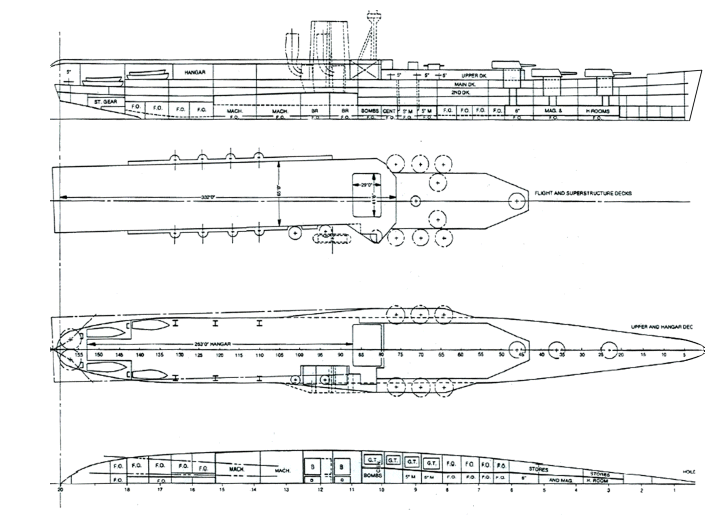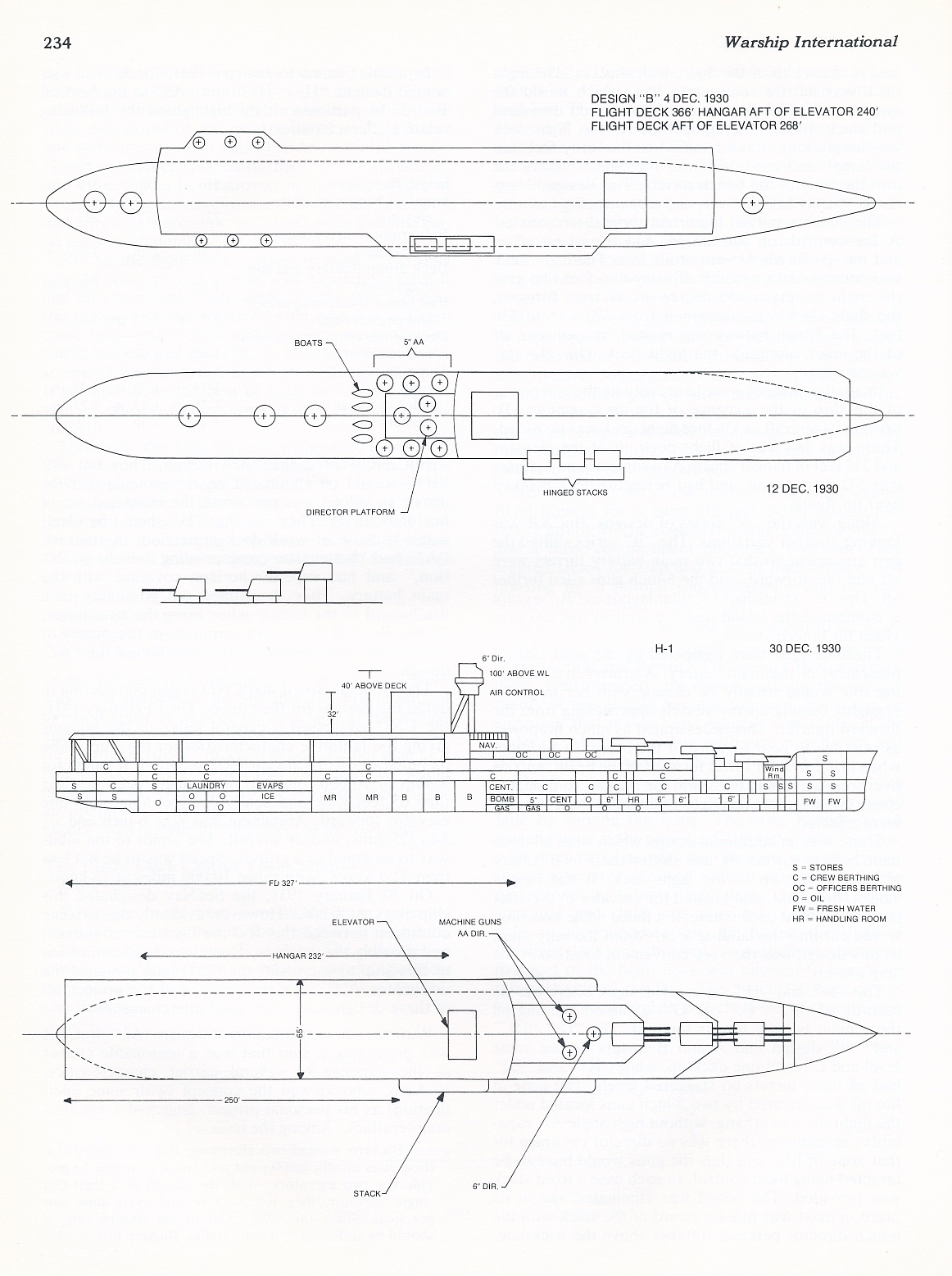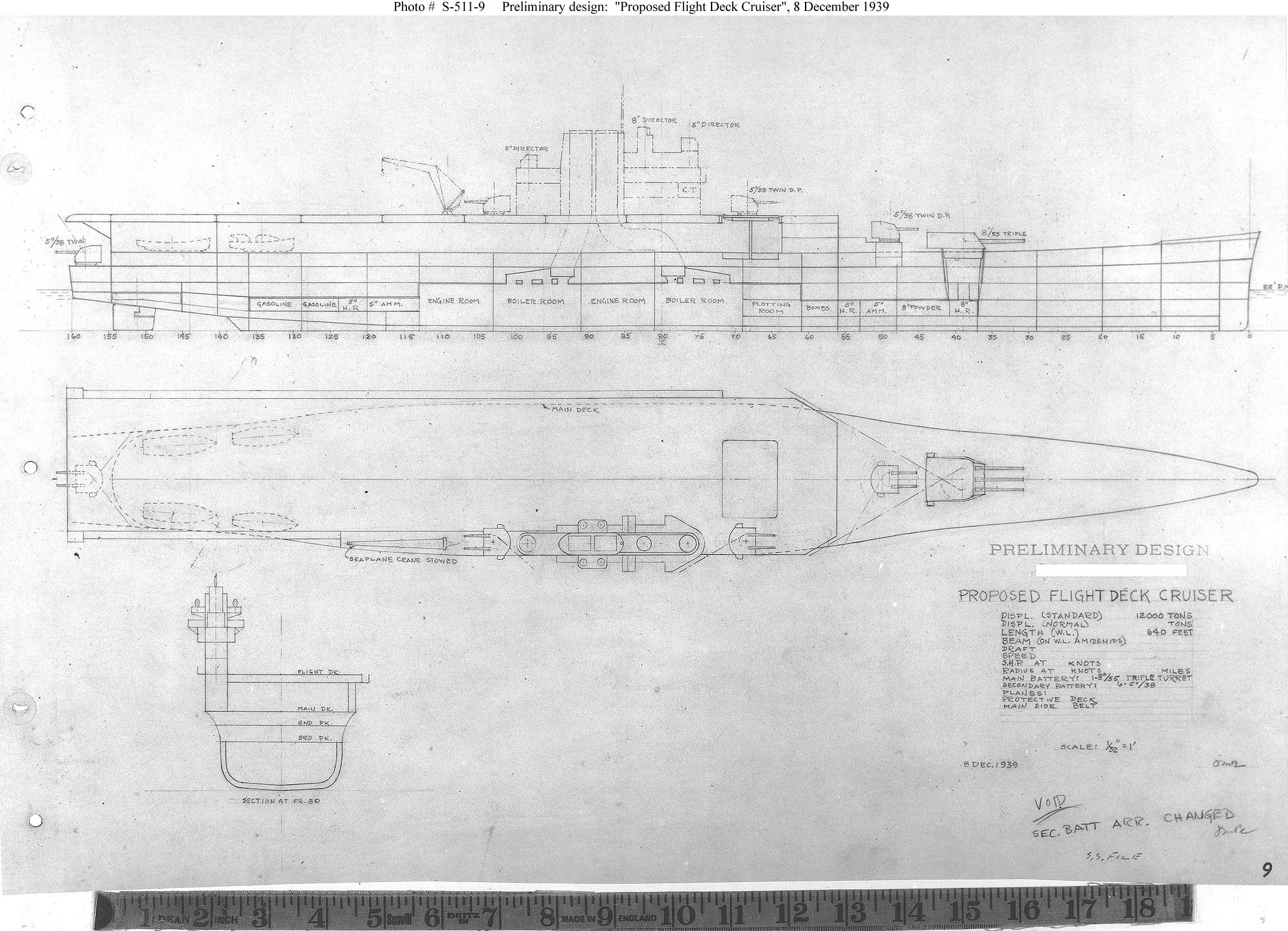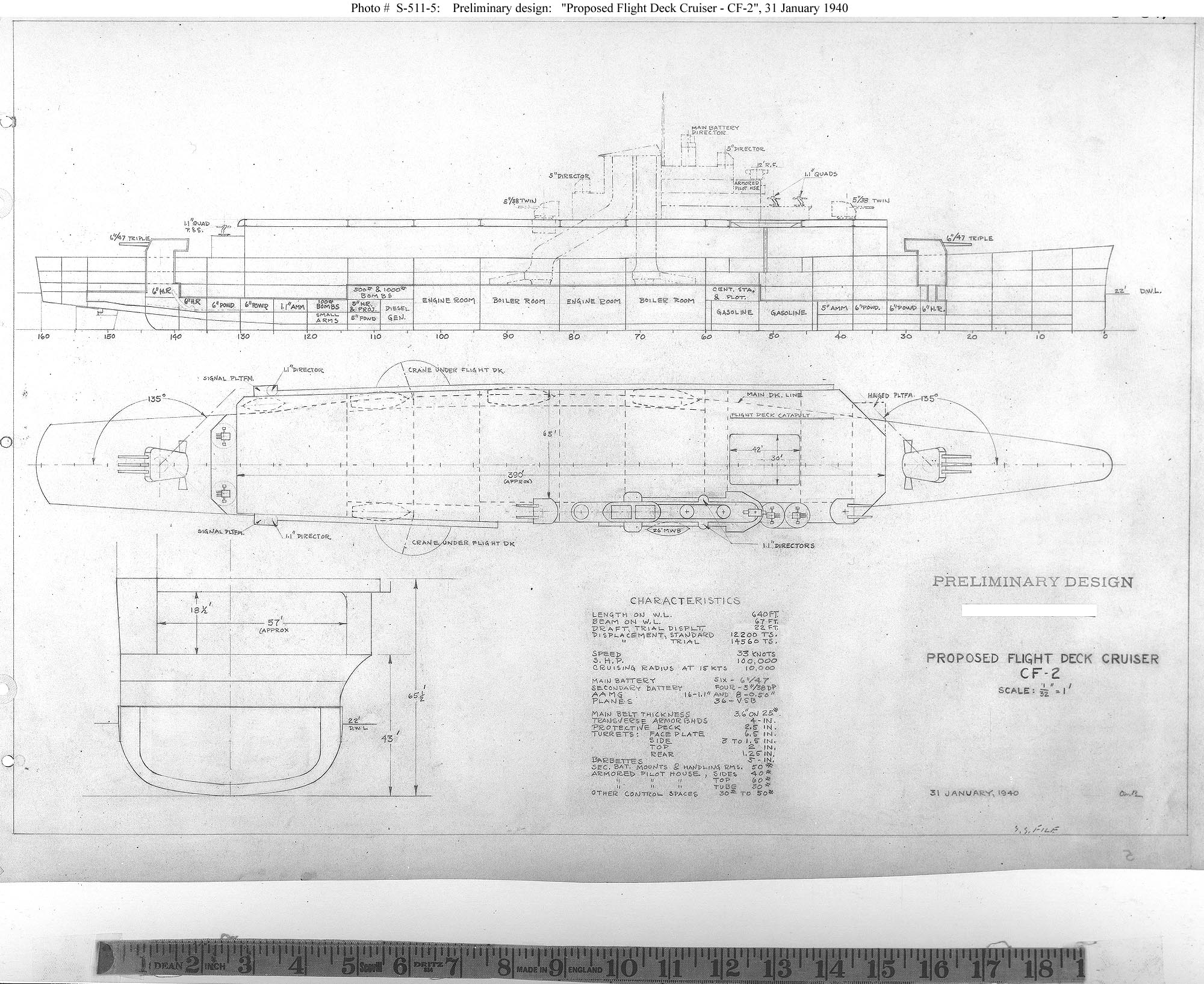Post by lordroel on Aug 20, 2020 17:08:54 GMT
US Navy Flying-Deck Cruiser design 1930
In 1931, the U.S. Navy was actively designing the flying deck cruiser. The restrictions of the Washington Naval Treaty on fortifying Pacific bases meant that the Navy knew that aviation would be ship borne during the cross Pacific trek of War Plan Orange. Seeking a way to bring aviation into the fleet at a faster pace than the limited funding for new carrier construction allowed and to circumvent the restriction on total allowed carrier tonnage in the treaty, the Navy came up with a cruiser with significant aviation capability.
At the time, Lexington (CV-2) and Saratoga (CV-3) were new to the fleet after protracted conversion times caused in large part by limited funding. There was still debate by the theorists on whether carriers should be large like Lady Lex and Sara or smaller. Ranger (CV-4), built small for the maximum possible air fleet, was still in the future to prove larger is better. Yorktown (CV-5) and Enterprise (CV-6) would be larger than Ranger with Wasp (CV-7) built small to use up the remaining allowed carrier tonnage.
At the London Naval Conference of 1930 the U.S. had clauses added to the London Treaty to allow for the flying deck cruiser. During late 1930 the various Navy bureaus presented design studies. The main contention was whether the cruiser would be a flush deck design or have an island superstructure. The superstructure won since fire control needed to be mounted on something and without it the ship looked like a carrier.
Rear Adm. William A. Moffett, head of the Bureau of Aeronautics 1921-33 and a great proponent of naval aviation, began to push for a cruiser that had aviation power to get more airplanes into the fleet by 1928. At British insistence there were no restrictions on the number of cruisers in the treaty. Moffett also advocated using large dirigibles as airborne aircraft carriers.
The risk of losing fleet air power concentrated in a few large decks concerned Navy planners: in the 1929 Fleet Problem IX Sara was lost. The cruiser, being smaller, cheaper and more numerous, would get aviation spread onto more decks. Also important, cruisers might actually get funded. Moffett through the Navy secretary requested five small carriers and only one received funding. Moffett planned to ask for seven flying deck cruisers to be built by 1936.
First designated as Light Aircraft Carrier (CLV) for Naval War College war games, the flying deck cruiser ended up designated as CF because the Chief of Naval Operations the felt that CLV would be confusing when compared to Light Aircraft Carrier (CVL). It was since CLV is understood today as a light cruiser with significant fixed wing capability. An apt description but CF is the historical designation. (Also, calling this a light carrier rather than a cruiser would seem to be a good way to bring protests from the other signers of the treaties.)
By June 1931 the design could be described as "a Brooklyn-class light cruiser forwards [and] one half of a Wasp-class aircraft carrier aft" and utilized an early version of the angled deck that would in the 1950s be adopted for use by fleet carriers, it would be 650 feet (200 m) in length, a 350-foot (110 m) flight deck and hangar aft for twenty-four aircraft, while forwards three triple 6-inch (152 mm) gun turrets were mounted, the standard armament for a light cruiser of the time. A secondary dual purpose armament of eight 5-inch (127 mm) guns was also projected to be carried for defense against enemy torpedo-boats and aircraft.
Image I of the the initial 1931 design

Image II of the initial 1931 design

Image III of the initial 1931 design

Wikipedia article: Flight deck cruiser
Good article with more designs of the Flying Deck Cruiser: The oddity that was the Flying Deck Cruiser
Secret Project thread: US Navy Flying-Deck Cruiser (CF) (1930-1931)
In 1931, the U.S. Navy was actively designing the flying deck cruiser. The restrictions of the Washington Naval Treaty on fortifying Pacific bases meant that the Navy knew that aviation would be ship borne during the cross Pacific trek of War Plan Orange. Seeking a way to bring aviation into the fleet at a faster pace than the limited funding for new carrier construction allowed and to circumvent the restriction on total allowed carrier tonnage in the treaty, the Navy came up with a cruiser with significant aviation capability.
At the time, Lexington (CV-2) and Saratoga (CV-3) were new to the fleet after protracted conversion times caused in large part by limited funding. There was still debate by the theorists on whether carriers should be large like Lady Lex and Sara or smaller. Ranger (CV-4), built small for the maximum possible air fleet, was still in the future to prove larger is better. Yorktown (CV-5) and Enterprise (CV-6) would be larger than Ranger with Wasp (CV-7) built small to use up the remaining allowed carrier tonnage.
At the London Naval Conference of 1930 the U.S. had clauses added to the London Treaty to allow for the flying deck cruiser. During late 1930 the various Navy bureaus presented design studies. The main contention was whether the cruiser would be a flush deck design or have an island superstructure. The superstructure won since fire control needed to be mounted on something and without it the ship looked like a carrier.
Rear Adm. William A. Moffett, head of the Bureau of Aeronautics 1921-33 and a great proponent of naval aviation, began to push for a cruiser that had aviation power to get more airplanes into the fleet by 1928. At British insistence there were no restrictions on the number of cruisers in the treaty. Moffett also advocated using large dirigibles as airborne aircraft carriers.
The risk of losing fleet air power concentrated in a few large decks concerned Navy planners: in the 1929 Fleet Problem IX Sara was lost. The cruiser, being smaller, cheaper and more numerous, would get aviation spread onto more decks. Also important, cruisers might actually get funded. Moffett through the Navy secretary requested five small carriers and only one received funding. Moffett planned to ask for seven flying deck cruisers to be built by 1936.
First designated as Light Aircraft Carrier (CLV) for Naval War College war games, the flying deck cruiser ended up designated as CF because the Chief of Naval Operations the felt that CLV would be confusing when compared to Light Aircraft Carrier (CVL). It was since CLV is understood today as a light cruiser with significant fixed wing capability. An apt description but CF is the historical designation. (Also, calling this a light carrier rather than a cruiser would seem to be a good way to bring protests from the other signers of the treaties.)
By June 1931 the design could be described as "a Brooklyn-class light cruiser forwards [and] one half of a Wasp-class aircraft carrier aft" and utilized an early version of the angled deck that would in the 1950s be adopted for use by fleet carriers, it would be 650 feet (200 m) in length, a 350-foot (110 m) flight deck and hangar aft for twenty-four aircraft, while forwards three triple 6-inch (152 mm) gun turrets were mounted, the standard armament for a light cruiser of the time. A secondary dual purpose armament of eight 5-inch (127 mm) guns was also projected to be carried for defense against enemy torpedo-boats and aircraft.
Image I of the the initial 1931 design

Image II of the initial 1931 design

Image III of the initial 1931 design

Wikipedia article: Flight deck cruiser
Good article with more designs of the Flying Deck Cruiser: The oddity that was the Flying Deck Cruiser
Secret Project thread: US Navy Flying-Deck Cruiser (CF) (1930-1931)









